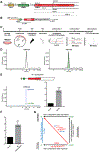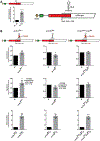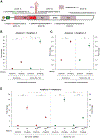Stem-loop-induced ribosome queuing in the uORF2/ATF4 overlap fine-tunes stress-induced human ATF4 translational control
- PMID: 38507410
- PMCID: PMC11058473
- DOI: 10.1016/j.celrep.2024.113976
Stem-loop-induced ribosome queuing in the uORF2/ATF4 overlap fine-tunes stress-induced human ATF4 translational control
Abstract
Activating transcription factor 4 (ATF4) is a master transcriptional regulator of the integrated stress response, leading cells toward adaptation or death. ATF4's induction under stress was thought to be due to delayed translation reinitiation, where the reinitiation-permissive upstream open reading frame 1 (uORF1) plays a key role. Accumulating evidence challenging this mechanism as the sole source of ATF4 translation control prompted us to investigate additional regulatory routes. We identified a highly conserved stem-loop in the uORF2/ATF4 overlap, immediately preceded by a near-cognate CUG, which introduces another layer of regulation in the form of ribosome queuing. These elements explain how the inhibitory uORF2 can be translated under stress, confirming prior observations but contradicting the original regulatory model. We also identified two highly conserved, potentially modified adenines performing antagonistic roles. Finally, we demonstrated that the canonical ATF4 translation start site is substantially leaky scanned. Thus, ATF4's translational control is more complex than originally described, underpinning its key role in diverse biological processes.
Keywords: ATF4; CP: Molecular biology; integrated stress response; ribosome; ribosome queuing; translation reinitiation; translational control; unfolded protein response.
Copyright © 2024 The Author(s). Published by Elsevier Inc. All rights reserved.
Conflict of interest statement
Declaration of interests The authors declare no competing interests.
Figures







Update of
-
Stem-loop induced ribosome queuing in the uORF2/ATF4 overlap fine-tunes stress-induced human ATF4 translational control.bioRxiv [Preprint]. 2024 Feb 18:2023.07.12.548609. doi: 10.1101/2023.07.12.548609. bioRxiv. 2024. Update in: Cell Rep. 2024 Apr 23;43(4):113976. doi: 10.1016/j.celrep.2024.113976. PMID: 37502919 Free PMC article. Updated. Preprint.
References
-
- Denoyelle C, Abou-Rjaily G, Bezrookove V, Verhaegen. M, Johnson TM, Fullen DR, Pointer JN, Gruber SB, Su LD, Nikiforov MA, et al. (2006). Anti-oncogenic role of the endoplasmic reticulum differentially activated by mutations in the MAPK pathway. Nat. Cell Biol 8, 1053–1063. 10.1038/ncb1471. - DOI - PubMed
Publication types
MeSH terms
Substances
Grants and funding
LinkOut - more resources
Full Text Sources
Miscellaneous

